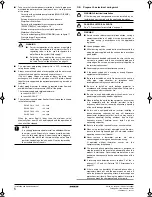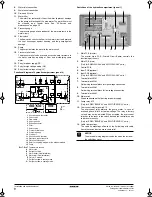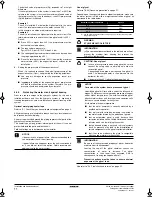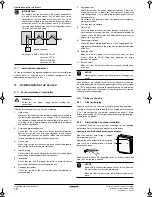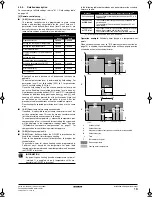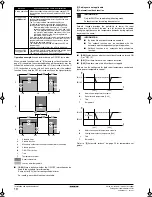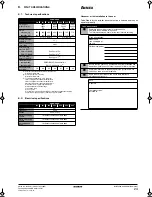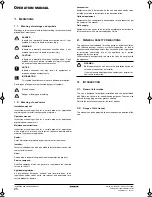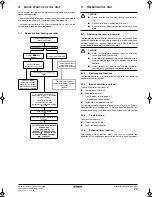
Installation and operation manual
11
EWAQ016~ EWYQ016~064BAW
Packaged air-cooled water chiller
4PW70082-1C – 2013.07
The default value of pre-pressure (Pg) responds to 7 m height
difference.
If the height difference of the system is lower than 7 m AND the
volume in the system is less than the maximum allowed value at
that pre-pressure (Pg) (see chart above), then NO pre-pressure
(Pg) adjustment is required.
Example 1
The unit is installed 5 m below the highest point in the water
circuit. The total water volume in the water circuit is 250 l.
In this example, no action or adjustment is required.
Example 2
The unit is installed at the highest point in the water circuit. The
total water volume in the water circuit (no glycol used) is 420 l.
Result:
■
Since 420 l is higher than 340 l, the pre-pressure must be
decreased (see table above).
■
The required pre-pressure is:
Pg=(H/10+0.3) bar=(0/10+0.3) bar=0.3 bar
■
The corresponding maximum water volume can be read from
the graph: approximately 490 l.
■
Since the total water volume (420 l) is below the maximum
water volume (490 l), the expansion vessel suffices for the
installation.
4
Setting the pre-pressure of the expansion vessel
When it is required to change the default pre-pressure of the
expansion vessel (1 bar), keep in mind the following guidelines:
■
Use only dry nitrogen to set the expansion vessel pre-
pressure.
■
Inappropriate setting of the expansion vessel pre-pressure
will lead to malfunction of the system. Therefore, the pre-
pressure should only be adjusted by an installer.
4.5.5.
Protecting the water circuit against freezing
Frost can cause damage to the hydraulic system. As this unit is
installed outdoors and thus the hydraulic system is exposed to
freezing temperatures, care must be taken to prevent freezing of the
system.
Optional water piping heater tape
Refer to "3.1. Check that you have all optional equipment" on page 3.
All hydraulic parts are insulated to reduce heat loss. Insulation must
be foreseen on the field piping.
A heater tape is winded around the piping to protect vital parts of the
hydraulic system inside the unit.
This heater tape will only protect internal parts of the unit. It can not
protect field installed parts outside the unit.
Field heater tape must be foreseen by the installer.
Use of glycol
Refer to "[8-04] Freeze-up prevention" on page 21.
Depending on the expected lowest outdoor temperature, make sure
the water system is filled with a weight concentration of glycol as
mentioned in the table below.
Caution: "Use of glycol"
Also refer to "5.3. Final check and test run" on page 22.
NOTICE
However in case of power failure, above mentioned option
can not protect the unit from freezing.
If power failure can happen at times the unit is unattended
or if you did not select this option, Daikin recommends
adding glycol to the water system.
Minimum outdoor temperature
Glycol
(a)
(a) See "[A-04] Glycol concentration setting" on page 21 for special settings when
using ethylene glycol.
–5°C
10%
–10°C
15%
–15°C
20%
WARNING
ETHYLENE GLYCOL IS TOXIC
INFORMATION
(a)
The concentrations mentioned in the table above will not
prevent the medium from freezing, but prevent the
hydraulics from bursting.
CAUTION: Use of glycol
■
In case of over-pressure when using glycol, be sure to
connect the safety valve to a drain pan in order to
recover the glycol.
Connecting a drain pipe is not required if no glycol is
used. The discharged water is then drained via the
bottom of the unit.
■
Using more than 40% glycol will damage the unit.
NOTICE
Corrosion of the system due to presence of glycol
Uninhibited glycol will turn acidic under the influence of
oxygen. This process is accelerated by presence of copper
and at higher temperatures. The acidic uninhibited glycol
attacks metal surfaces and forms galvanic corrosion cells
that cause severe damage to the system.
It is therefore of extreme importance:
■
that the water treatment is correctly executed by a
qualified water specialist;
■
that a glycol with corrosion inhibitors is selected to
counteract acids formed by the oxidation of glycols;
■
that no automotive glycol is used because their
corrosion inhibitors have a limited lifetime and contain
silicates which can foul or plug the system;
■
that galvanized piping is not used in glycol systems
since its presence may lead to the precipitation of
certain components in the glycol’s corrosion inhibitor;
■
that it has to be made sure the glycol is compatible
with the used materials in the system.
INFORMATION
Be aware of the hygroscopic property of glycol: it absorbs
moisture from its environment.
Leaving the cap off the glycol container causes the
concentration of water to increase. The glycol
concentration is then lower than assumed. And in
consequence, freezing can happen after all.
Preventive actions must be taken to ensure minimal
exposure of the glycol to air.
4PWEN70082-1C.book Page 11 Wednesday, September 25, 2013 7:31 AM
Содержание EWAQ016BAW
Страница 47: ......
Страница 48: ...4PW70082 1C 2013 07 Copyright 2011 Daikin...









